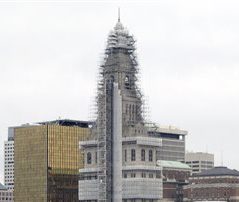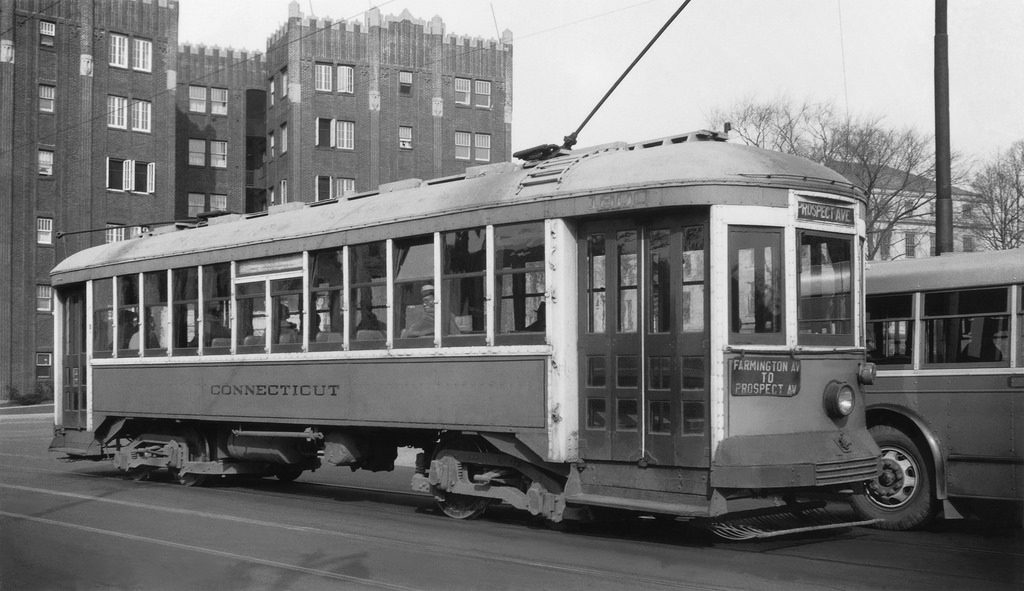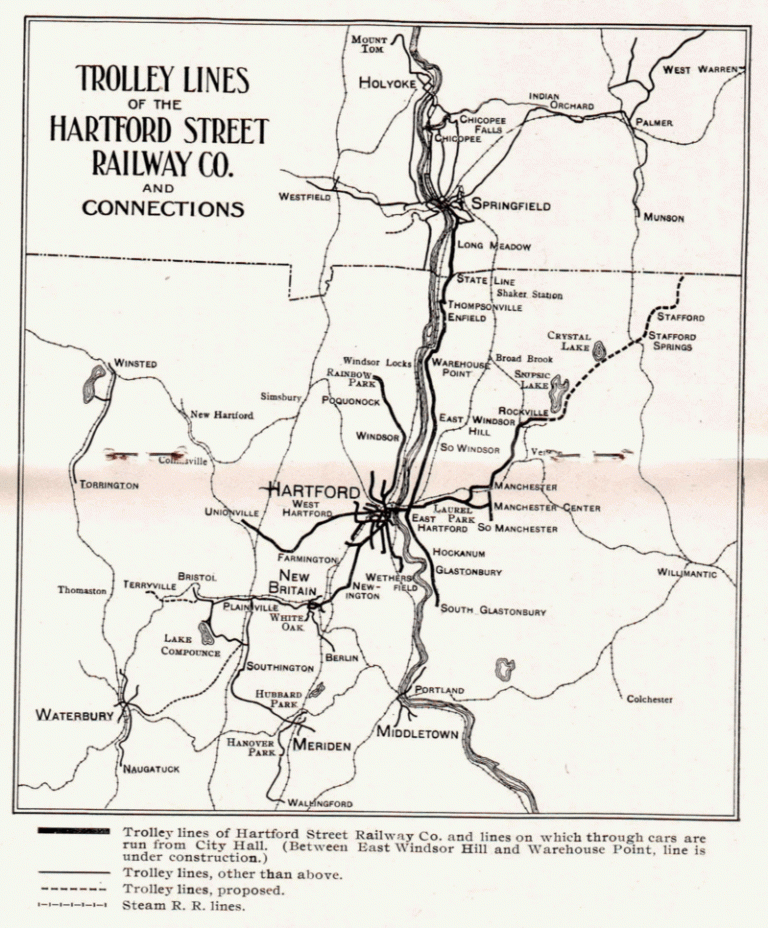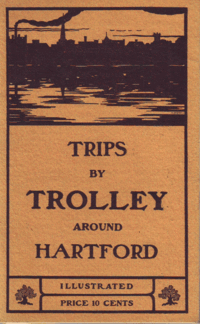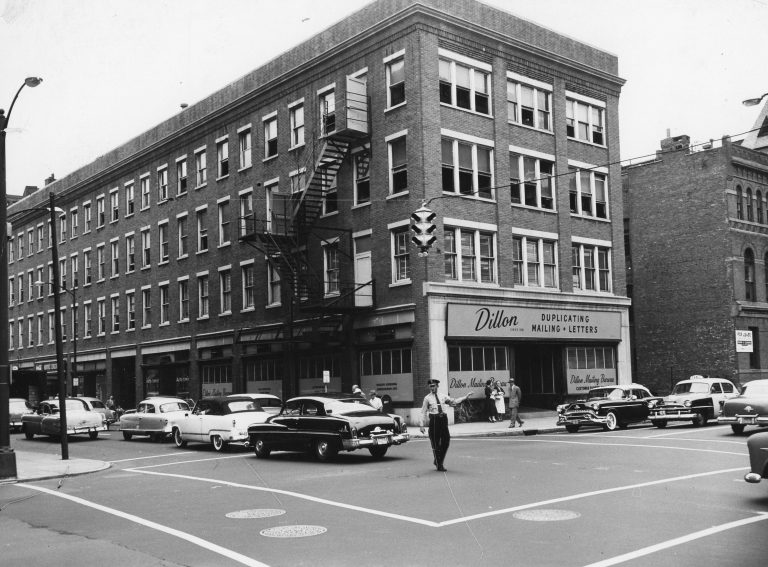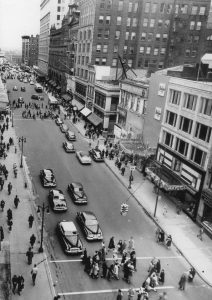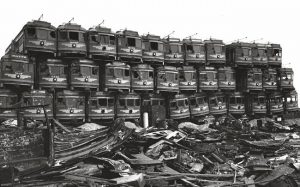The Death and Life of the Hartford Streetcar
By: Evan Metzner
Moving through Hartford today, it quickly becomes obvious that the automobile is the primary means of transit. Driving is a requirement for almost any trip or activity, and alternatives are either last resorts or non-existent. In short, the car is now king. However, it was not always this way. There was a time, a time before our streets were sacrificed to rubber and oil, that a different beast ruled the streets of the capital. Slipping quietly through the city without fear of congestion or emissions, the streetcar was the king of the city long before Detroit brought the car into the world to steal the crown from its older brother. But all reigns must end, even that of the noble streetcar.
The car was ruthless in its attack, working with Machiavellian efficiency to remove any trace of the streetcar from both the urban landscape and the minds of the citizenry. With a combination of ethically questionable tactics, superior marketing and timing, and genuine quality of life improvements for some, the car eventually defeated the streetcar and the car rose to absolute power. That was sixty years ago. As the decades slipped by and the streetcar faded further into legend, its permanent extinction seemed all but inevitable. However, as Heraclitus said many years ago, “the only thing that is constant is change”. The reign of the car, while long, could never last forever. And now, from the brink of its third death, the streetcar is rising like a phoenix from the ashes to once again do battle with this automotive usurper. This time, the future is unclear. The streetcar has some new weapons in its arsenal but the car still has many great advantages over its older brother. Perhapsthey may even make peace and some blending of the two will end up taking the day. Either way, to understand how this next shift in transportation orthodoxy will change Hartford and cities like it, it is pivotal that the previous shift from streetcar to car, and its effect on Hartford, are fully understood.
Hartford’s Transit
Hartford is currently a fairly typical mid-sized city. As in most of America, people drive to work on wide multi-lane avenues, wait in the inevitable rush hour traffic jams on one of the many surrounding highways, and tend to view the public transit network as something to be tolerated only when necessary. In 2016, 72.5% of workers in Hartford commuted by car, with an average commute time of 22 minutes. These auto commuters dominate the relatively paltry 15% of the city who commute on the bus or train network and the 6.5% who walk. The figures are similar, in most mid sized-cities around the country. There are many reasons for this dominance, ranging from poor public transport and pedestrian infrastructure to state and city laws that enforce parking quotas and other pro driver policies. All of these factors influence behavior; however, the overwhelmingly negative perception of public transport is the main culprit in creating this transit discrepancy. The real question, how did this perception come to be so widely accepted, is more difficult to answer and requires a deeper dive into the creation of the current transit system.
While it may be hard to imagine today, it was not so long ago that Hartford was flush with public transit options. In fact, as late as 1935, the whole northeast corridor between New York and Boston was connected through a series of local and regional transit networks. These networks were made up of streetcars, and they used to rule the roads throughout Connecticut. These streetcars or tram networks were prolific, with even small towns like Enfield or Bristol maintaining their own streetcar lines. Streetcar lines became so common that, with enough patience and stamina, one could travel from Newark Delaware to Maine solely on local streetcar networks. This feat would be inconceivable on local public transport networks today. At its peak, there was more than 600 miles of streetcar track in Connecticut. Hartford was the largest district in the state, with twenty “radial lines” in the district alone, allowing for connections from Meriden to Springfield. People loved streetcars and these networks were flourishing.
However, between 1925 and 1945, almost all of the streetcar infrastructure in Connecticut disappeared, seemingly overnight. The car had arrived, tearing up and paving over any streetcar tracks in its way. By 1941, all streetcar lines in Hartford had been replaced with bus lines or removed. New Haven, the last bastion of streetcar infrastructure left in the state, ripped their own tracks out in 1948. This was the final killing blow to the age of the streetcar, the final chapter in the life of the fallen king of the Connecticut streets. This transition was massive, not only changing the way people got around their cities and towns, but revolutionizing the national economy and setting the stage for more than half a century of car-based urban policies. This led us, quite literally, down the road to sprawl, infrastructure neglect, and eventually to the gridlock we have all come to know from our cities. However, for such an impactful change, the question behind why the transition took place is not well understood.
Inferiority Complex
For some the answer is obvious. The car was a superior product, simply the newest technology supporting the upward sloping line that represents quality of life in the post-industrial age. Its easy to see the allure of this answer. The car did have substantial benefits, greatly increasing the potential range of human activity and allowing people to more effectively and affordably move out of crowded, dirty, and sometimes dangerous urban cores. But this answer is too simple, too pure. The truth is never so easy. While the car did allow people to escape urban centers, the dream of the fifteen-minute commute on wide open freeways was very short lived, if it ever existed at all. The density at which a streetcar can move people is much greater than that of individual cars, and planners soon found their infrastructure to be increasingly inadequate for growing populations, creating congestion and gridlock that carried with it tremendous social and economic burdens.
In Hartford, these problems were made apparent early on, as major new construction to relieve downtown congestion began being seriously planned as early as 1948, only seven years after the removal of the streetcar. The planning only even took this long due to delays associated with wartime production. This new construction would eventually take the form of the dual interstate system running through Hartford, I-84 and I-91. These high capacity roads were meant to relieve congestion and return Hartford to a car-centric utopia. However, and you may notice a trend here, these early planners had miscalculated. The field was just starting to learn about the law of induced demand, basically stating that the temporary reduction in traffic caused by adding new lanes to a freeway will attract more drivers looking for better commutes, only creating more demand and cancelling out any actual improvements in traffic reduction. This fact paired with some questionable construction decisions created a freeway system that would shortly be overwhelmed, surpassing its intended capacity just a few years after its completion. In this way, Hartford has barely seen the advertised benefits of car-centric living in full.
Recent research has even further challenged the idea that car-based commuter lifestyles are better for our health and well being. First, while the city was certainly dirty and polluted before, cars have made that problem substantially worse, with studies connecting higher local emission levels with increased asthma attacks in Children. At the same time, numerous studies have demonstrated that the isolation and lack of community interaction that occurs to a greater extent in the suburbs can be detrimental to our mental health as well our development of empathy for those different than ourselves. These are serious problems birthed primarily by the rise of the automobile and its connected effects.
The Conspiracy
f not inherently a force for good, why then did the car defeat the streetcar so handily? Many would point the finger at the big auto interest groups in Detroit and not without merit. The story goes that a company called National City Lines, which owned and operated several streetcar lines around the country, got bought up by GM, Firestone Tire, Standard Oil of California, Phillips Petroleum, and Mack Trucks, all of which have obvious interests in advancing cars as the primary means of transportation. National City Lines then proceeded to buy many streetcar lines around the country with money received its car-centric investors, eventually owning up to 100 local and regional companies. These new lines were often converted to bus transit networks, or just removed completely. This culminated in the 1949 conviction of all companies involved for conspiracy to monopolize interstate commerce in the sale of buses. Controversially, they were acquitted of conspiracy to monopolize transit services. While an attractive though frustrating theory, it is only partially accurate. While there were certainly some shady business practices involved, there is strong evidence that the streetcar companies bought by National City Lines would mostly have gone bankrupt and closed regardless of their purchase. This financial difficulty was due in part to the automobile, which congested the roads even before the removal of the streetcar and often slowed streetcars enough to throw them off their schedule, reducing reliability and thus demand. Secondly, there were many local and state laws that restricted raising fares, making it difficult for these companies to make money as they were unable even to match inflation, over time straining already tight budgets. The truth of course lies somewhere in the middle, with factors both structural and malicious playing a role in the streetcar’s demise.
The Return
But as we now know, the demise of the streetcar was not permanent. While not much changed between 1950 and 2010, cities from Portland Oregon to Washington DC have recently begun implementing streetcars into their public transit networks. Spurred by the success of these early adopters, cities throughout Connecticut, including Hartford itself, have begun drawing up plans for new streetcar systems. Hartford planners hope that a mass transit system like a streetcar could help relieve congestion in the crowded downtown as well as positively affect real estate commerce around transit hubs. This last bit is important. Franklin Conaway, a streetcar transit consultant, argues streetcars and “dedicated rail lines help businesses” to a greater extent than buses, “because retailers and other know exactly where the transit line will be” and that they won’t be easily changed. This effect can be dramatic, and could help raise property values in Hartford’s central city, a fact not lost on the tax starved city government. Streetcars have also been said to increase economic activity due to their tendency to have short distances between stops as well as short waits at each stop. This encourages riders to take shorter rides than they would on other transit options, as taking the streetcar just two or three blocks to move about downtown is a viable option.
Given the public transport revolution that has been occurring across the country over the past few years, the revitalization of the streetcar in Hartford doesn’t seem so far fetched. However, that revitalization depends on two things, public support and significant funding, neither of which the city has an adequate supply of. For the street car to win this battle and reclaim its place as king of our streets, it will need to start a revolution. Not just in the planning field, but in the hearts and minds of the residents.
